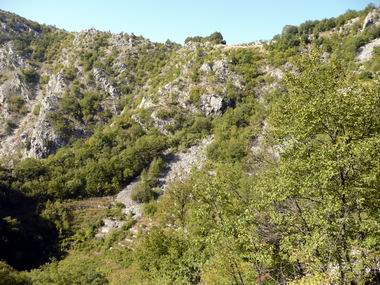
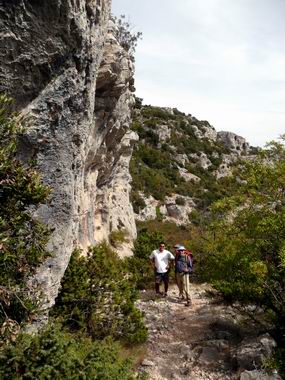
Hiking in Hrvastska
September 15, 2007 Ė October 2, 2007
Page 2
We took a minibus to go to Makarska,
the next region to hike, where we stayed six days.The coastal town was
picturesque and quiet. We took a boat from here to the island of Brac,
pronounced Brash. Croatia has 125 islands. We docked in a harbor after
more than an hour. A fishing town greeted us. We took a bus ride to the
mountain and we hiked to the top; it was not a bad hike. The mountains
are big, rocky and rugged. On the way up we passed many cyclists on the
road, some of whom were struggling but nevertheless still going, and not
all of them were wearing helmets. We also passed hikers. On top of the
mountain there were tall microwave towers and a restaurant, where we had
a spaghetti lunch, which was not the best meal we had on this trip.
 |
 |
Going down the mountain back to the
boat we split into two groups, five of us, (the toughs) chose to hike down
and the others, (the wimps), went by bus. More than two hours later we
met at the dock. The hike was very strenuous. The path was covered with
loose small rocks which I soon began to feel through my boots. The path
was a continuous switch back. We met a few hikers on the way. We made it
down going through the village of Bol. We passed by a house which has a
most beautiful pomegranate tree with a large load of fruit. There were
also lots of olive trees in the yards. The trees were heavily loaded with
very plump olives. The shingles on a few of the old roofs were not the
usual red tile, but stone slates.
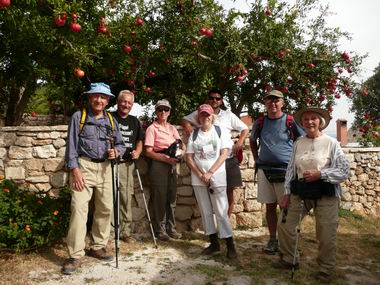 |
 |
We met with the rest of the group
and took the boat back to Makarska. The captain made us a nice snack of
bread, olives, cheese and fatty meat. He served us water and wine and more
wine and we finally docked at 6:30 after a long and hard day.
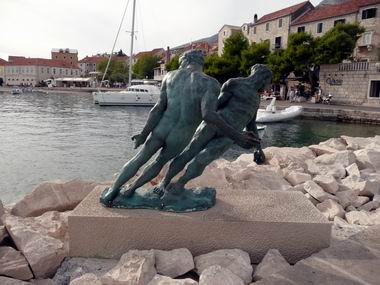 |
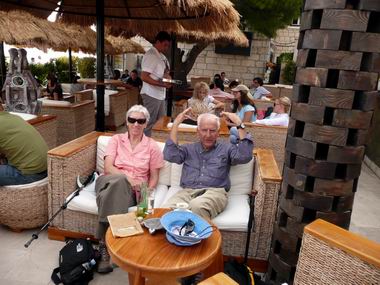 |
Croatia seems to be all mountains,
rocky and rugged. All of our hikes have been on rocks. We took a bus for
an hour's ride through nice looking villages. When we stopped to begin
our hike there was a gorge ahead of us. We started walking on a rocky narrow
path. I am glad no one slipped, because an accident would have been deadly.
One would have plunged hundreds of feet down with no rescue possible. The
path was switchbacks with sharp turns. At the bottom of the gorge was a
small lake. After a rest stop half of us took a wrong turn and we were
lost and separated from the rest of the group. Our leaders used cell phones
to communicate with one another. Five miles later, in this rugged terrain,
the two groups met and continued walking on what looked like a small but
long earthen dam. Then we walked in a huge meadow until we met our bus
at the edge of a village. We were very happy to see it since we were very
tired by then.
 |
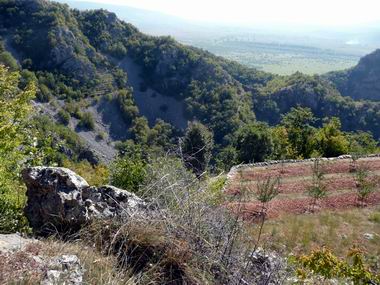 |
We went to a farm house where they
prepared walnut brandy for us, which was not bad considering I donít care
for brandy. They also had a large bowl of fresh figs and I had a bunch
of them. They showed us how they cooked for us a special meal of meat and
potatoes in a clay oven covered with charcoal. This was similar to what
we had back home years ago, (taboon). We sat outdoors at a nice long table
with wines, water and tasty home made bread. The first thing we had was
the usual cabbage salad which I liked. Then they brought trays of food
and it was heavenly.
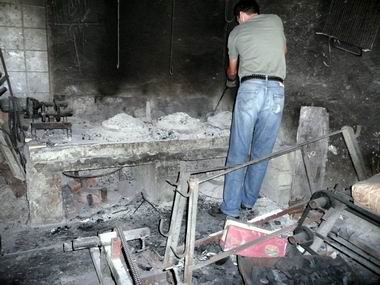 |
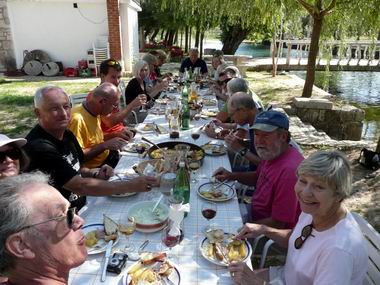 |
We continued walking and arrived at
a deep cone shaped gorge at the bottom of which is what they call Blue
Lake. There was something built in the shape of a pulpit used as a lookout
at the lake or for blessing the visitors. From there we saw another lake
called the Red Lake because of the reddish rocks around it. It was hard
to throw a pebble into the water because it was so deep and had a conical
shape. The pebble would land on the side before it reached the water. Only
one person, a local young man, was able to throw a rock in the lake.
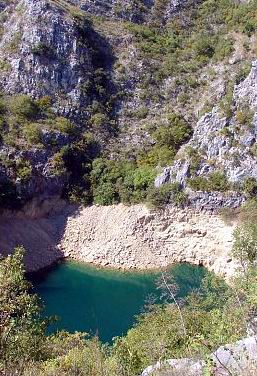 |
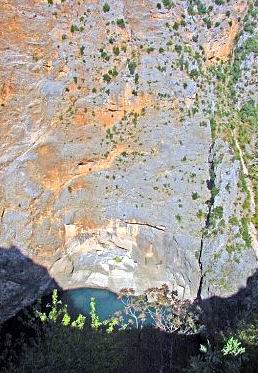 |
|
|
|
It was rainy one day and the program
was therefore changed. The bus later took us up the mountain on a very
steep one lane road. We met a minibus coming down followed by another.
They both had to back up until there was a spot for us to pass. It was
tricky maneuver for a bus on a winding road. Along the way, we passed by
horses in a field which were brown, black and white, an usual combination
of colors. Finally we came to a hut, staffed by a woman who looked to be
very cold. It is too far up the mountain to have electric power for lights
and heat. She only had a gas heater. I asked her about what was she doing
and she said she was receiving tourists. She gave us literature about the
mountain.
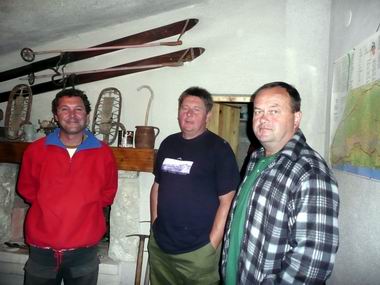 Cooks Cooks |
 |
As we tried to continue our treck, the bus refused to start, so we pushed it until it fired up. We resumed our travel and came to another and bigger hut. Three men there cooked lunch for us. We started with cabbage and tomoato slices, home made bread and lots of wine. The main dish was goulash.
One day we hiked up a mountain covered
with thick trees then came down in light rain. The rocky path, as we seem
to walk always on rocks, was wet, Two and a half hours later we were at
the bottom of the mountain, where there was a winding river in a beautiful
valley. To cross the water, we took a boat, which was tricky to get on,
and the old engine chugged along to the other side of the river. Getting
off was just as tricky because there were no docks, only the dirt enbankment.
We met our minibus, which drove us for the next hour to a village. Its
alleys were narrow with just enough room for a bus and nothing else, not
even a cat. It was funny to watch the driver negotiate the road.
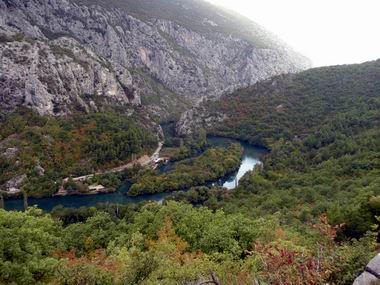 |
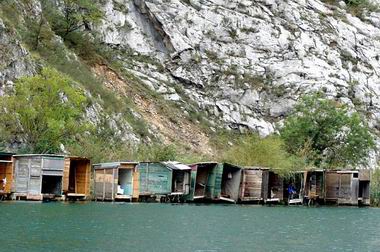 Fishing Fishing |
We went to a quaint restaurant, in
which one dining room was in a cave. We visited the kitchen where they
cooked the food on coal. They gave us the usual brandy drink they call
Grappa, pronounced gra pa. It is made me a little dizzy after a while.
The salad we got was the usual cabbage with tomotos, red pepper and onions.
The main dish came from the oven and was a platter of chicken and potatoes.
It was cooked very slowly. The meal was a treat.
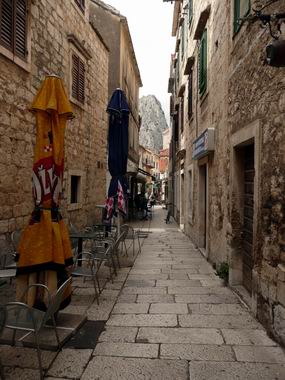 Omic Omic |
Locals
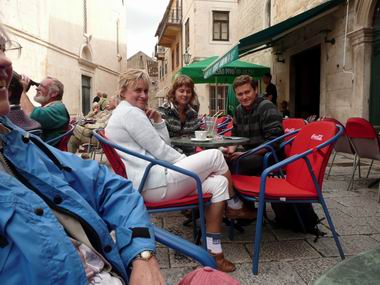 |
We took the bus once again back to
the river and the same blooming boat ferried us to the village; Omic (omich).
It was a very beautiful place with narrow stone streets and alleys. We
walked around, had refreshnments in the open door cafes, and observed the
locals as they observed us. We rode the bus back, but a few of us (the
toughs) got off three miles before reaching the hotel and walked all the
way back along the beach.
Dubrovnik:
We transferred by bus to the Dubrovnik
area, the last of our three destinations. The road stayed within close
proximity to the Adriatic Sea. All coastal communities have red roofs,
and big mountains behind them. They were very picturesque. Croatia has
two land masses separated by a small stretch of Bosnia. The border police
just waved our bus on. We stopped in a small border resort town of Neum
for rest. The first town we stopped in when we entered Croatia again was
famous for producing sea salt. The city of Ston is surrounded by a big
wall, second in size to the Chinese wall. It was difficult to climb because
it is all steps, but the view from above was lovely with the red-roofed
houses of the town below. The wall was built in the 14th century to protect
the city from the Ottomans. The renovation work on the old wall was immaculate.
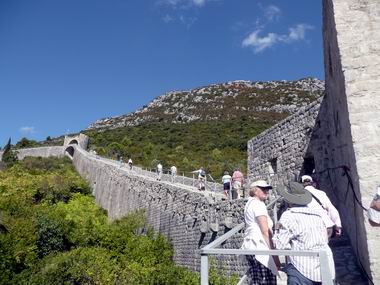 |
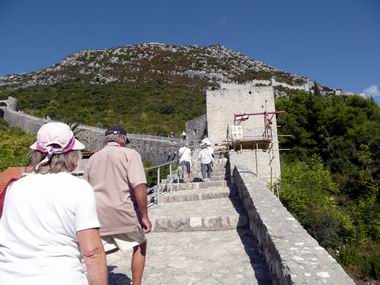 |
Last summer, fires swept through parts
of Croatia close to Dubrovnik. It is amazing how close the fires
came to the houses, but they were not harmed, partly because the houses
were built of stones. The house building material was decreed by law centuries
ago. We reached our destination at a Dubrovnik suburb of Cavtat. Later
in the day we walked around the peninsula of Rat. The town had old alleys
lined by houses with large courtyards. It is also the birthplace of the
necktie. In the past people wore bright scarves around their necks and
these were tied in a special way. The fashion traveled to Paris and the
Cravat (necktie) was born and spread.
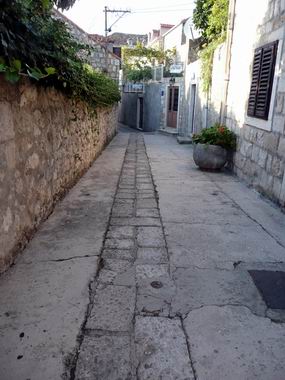 |
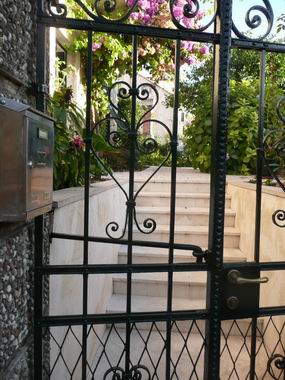 |
The country is famous for its beaches
but I did not see any to speak of. In most settings, the mountains came
to the water's edge. Beaches are very clean, water is clear and there were
no big hotels right on the beaches. Swimmers lay around on rocks. When
there is a space between the rocks, they poured cement to make platform
like patios, no bigger than the regular backyard variety. Someone would
then put up chairs for rent at these patios.
 |
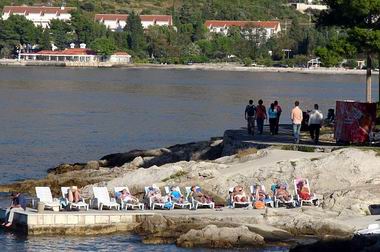 |
Our first hike in this region was
six easy miles with a slight elevation in wooded areas. I seem to be repeating
myself. We hiked and hiked. We arrived at a town which reminded me of my
home town Palestine. People had fruit trees in their yards, like pomegranate,
lemon, orange, quince,figs, olives and vegetables.
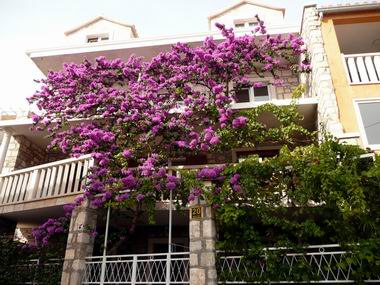 |
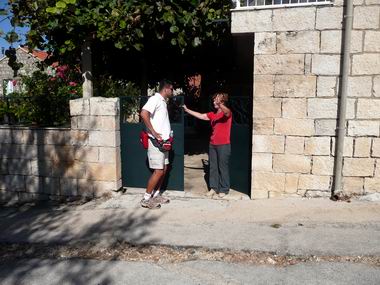 |
We continued our hike to a place where
there was a folk dance group. Our leader could not find it and stopped
a passing car to ask. The driver turned out to be a Japanese American who
asked our guide for direction to a vineyard. Our guide then asked a woman
watching us in front of her house. We finally got to the place and there
were lots of people waiting to see the show. I sat among the French visitors
and they seem to resent my presence. The two women on either side of me
kept looking at me as if I came from Venus.
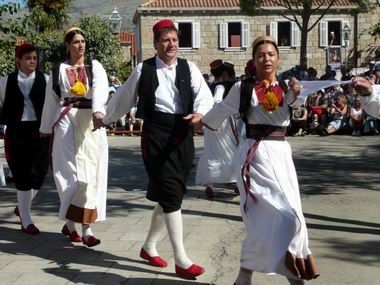 |
 |
The show was beautiful. The men wore baggy pants which the Turks wore. The Palestinians did too. I even had one. The baggier the pants the better. The dance was similar to Greek dances and so was the music. The dancers held one anotherís hands forming a line and trotted around with fancy footwork.
Our minibus drove us to a mountain
top in the boonies and we came to an old house that was renovated into
an outdoor restaurant. I did not like the lunch today unlike the other
surprise lunches we have had every day. It was a salad (the usual) and
a plate consisting of an assortment of cheese, olives, wine and good bread.
That was only an appetizer to me.
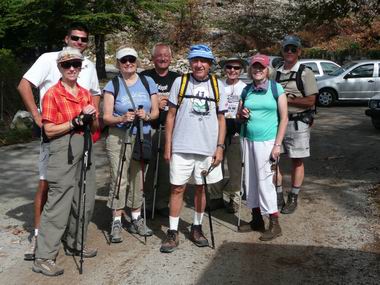 |
 |
 |
 |
To go back to the hotel, we split into two groups, the wimps who rode the bus back and the seven tough ones who hiked down the mountain in two hours. The path was rocky as usual, with rugged switchbacks through the area where the fire took place last summer. When we got to the town of Cavtat, we stopped by a coffee shop and had drinks.
There was no hiking on our last day
here. We were scheduled to take a boat to Dubrovnik. It took about an hour
to get there on a 50 foot boat negotiating a rough sea, but the scenery
was gorgeous. Coastal towns were beautiful with red roofed houses by the
deep blue water and surrounded by high mountains. The bottom half of the
mountains were green and the top, rocky and steep. It was sunny and warm
but pleasant. The first thing we did was to walk on top of the protecting
wall. It was very high and it was a wonder how it was built. It had many
steps which we climbed including the towers. The view of the city was fascinating
with all red roofs, alleys and the blue sea.
 |
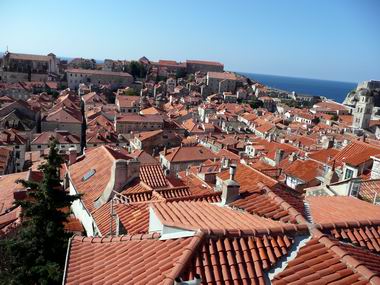 |
The cityís inhabitants were the rich
merchants, and they built Dubrovnik on a grid, which was not the norm for
the old world. They also believed that the north wind coming down the alleys
protected them from malaria by blowing the germs away.
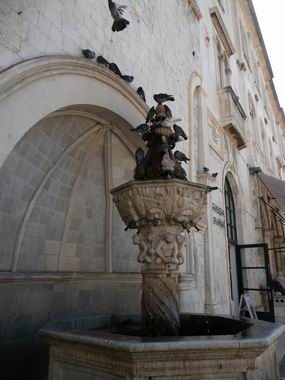 |
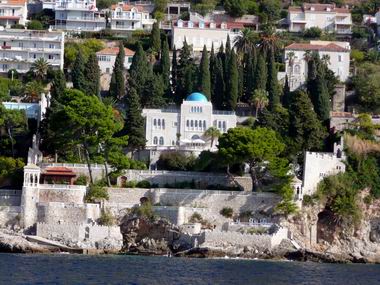 |
Dubrovnik has an interesting history by not going to war with the invaders of the past. They made treaties with the Romans, Ottomans, Venetians and Napoleon. The Serbs did however, bomb the city in 1991. The Ottomans, though were not the rulers of the town, received an annual tax from the city, which spared it from destruction. In the middle of the city there is a Jewish district. While the Ottomans did not rule the city, the Sultan supported the Jewish immigrants from Spain. This support negates all the western perceptions that the Turks mistreated the non Muslims.
Food:
Our daily breakfasts and dinners were
generally western cuisine with few variations. Lunches were however, pleasant
surprises everyday. We hiked the mountains away from the major population
centers. Then, we were pleasntly surprised when we landed at an old house
where an excellent treat was prepared for us. On a few occasions cooking
was done on coal in old fashioned ovens. Portions were reasonable, not
the American size on 13 inch plates.
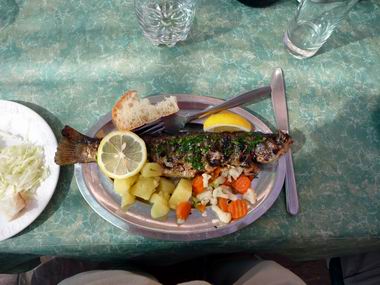 |
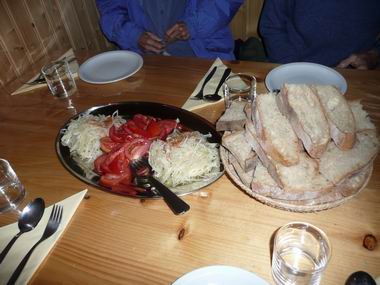 |
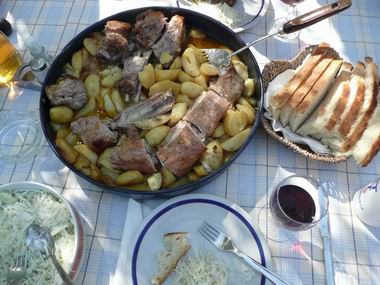 |
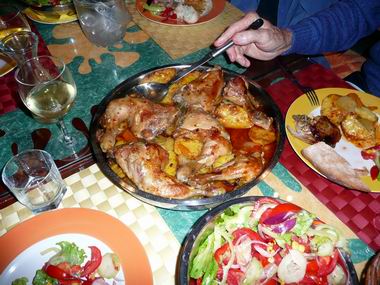 |
Often we ate outdoors and always were
first served Grappa, a liqueur made from the skin of the grape after exctracting
the wine. I enjoyed the roasted vegetables which were nicely prepared.
Fruits were good. Protein was mainly from veal and to my disappointment
was not fish. The government taxes fishing heavily because of the over
harvesting. One evening I invited our Croatian guide for a fish dinner
at a local restuarant of his choice. We had Grappa every day before lunch,
It was surprising not to see corn as a cooking ingredient. People there,
as in most of Europe, use corn for animal feed.
Conclusion:
The hiking program was confined to the Dalmation coast of Croatia.The coastal area is very pictursque with the blue waters of the Adriatic Sea overlooked by imposing mountains and villages nestled in bays. I liked my travel group, some of whom were good hikers and they generally had a good sense of humor. Food was tasty, but lunches were fantastic especially, the home made bread. I was disappointed in not having more fish being so close to the sea.
We had two guides, Rolf, a Swiss and a young Croatian man, Ivan, pronounced evon, who lived in New York when he was young. My biggest disappointment in the program was the lack of lectures about the country that we all were expecting, and is normally a part of Elderhostel policy. Ivan knew about the country as any young man would, but without the nuances of history, culture, economics, government, or relations to the EU.
During our hikes in the isolated areas
or far from towns, it is impressive that Ivan had a cell phone connection
without exception. The government here does not issue an operating license
unless the provider can guarantee full coverage all over the country. That
is impressive, and is obviously possible.
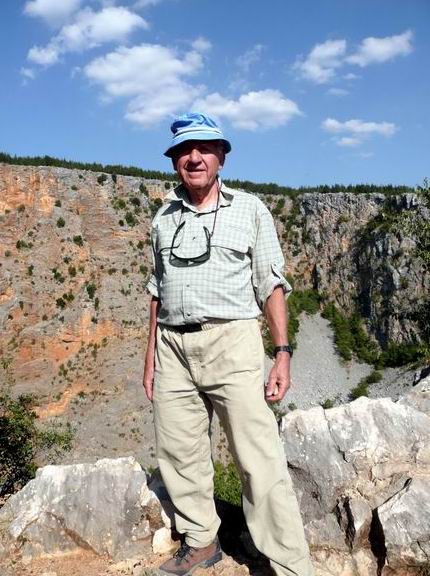 |
Acknowledgements:
The author wishes to thank Barbara Staggs for some of the pictures appearing in this document, which were chosen from her collections with permission. The author thanks Jo Ferrando for her editing and improving the readability of the report.
For information, please contact the
author: Ned Audeh